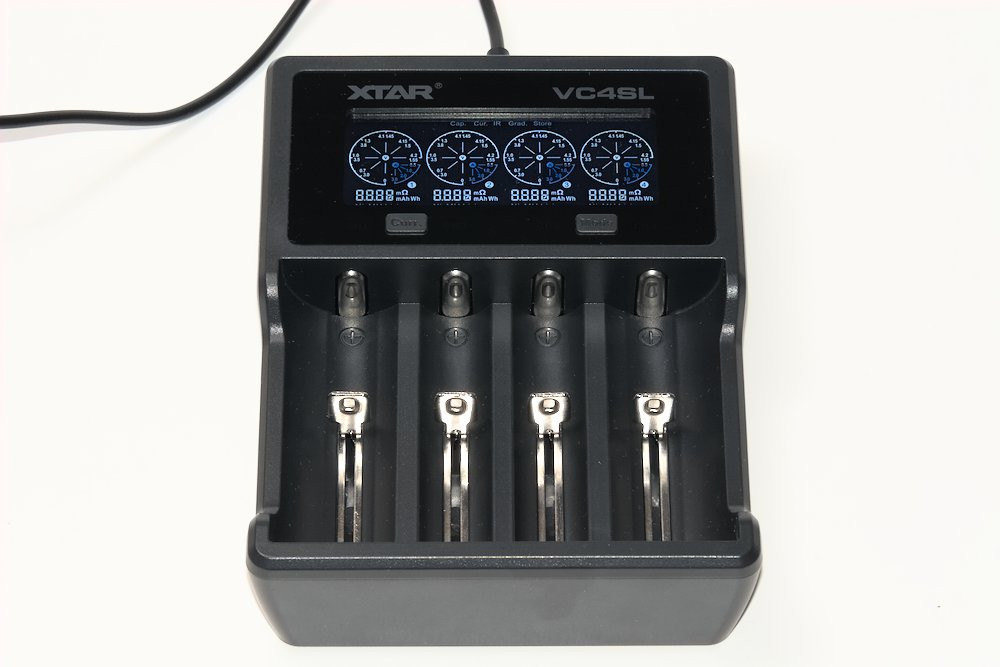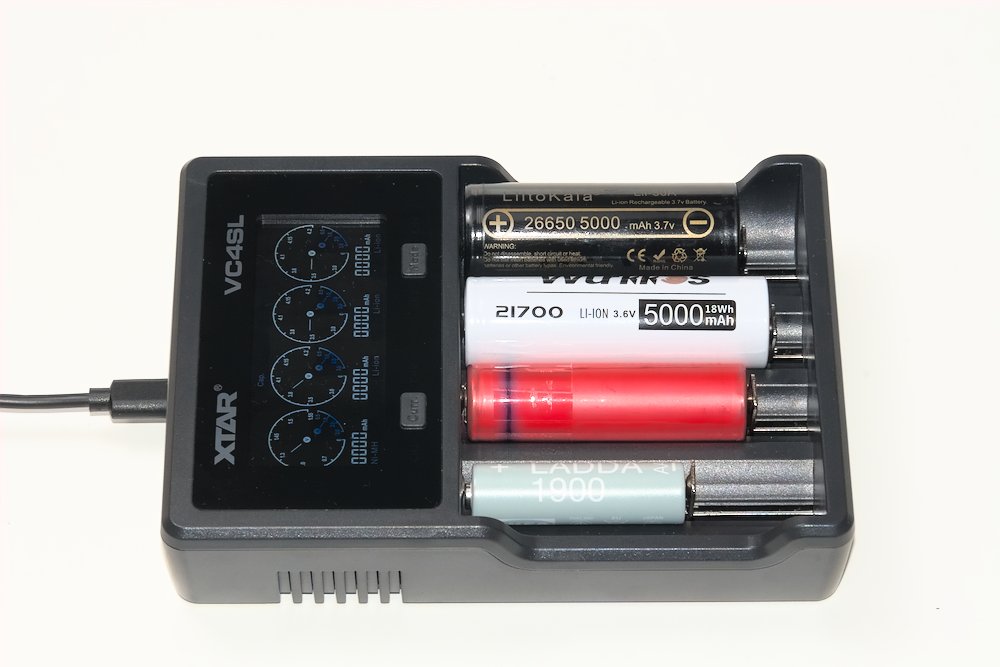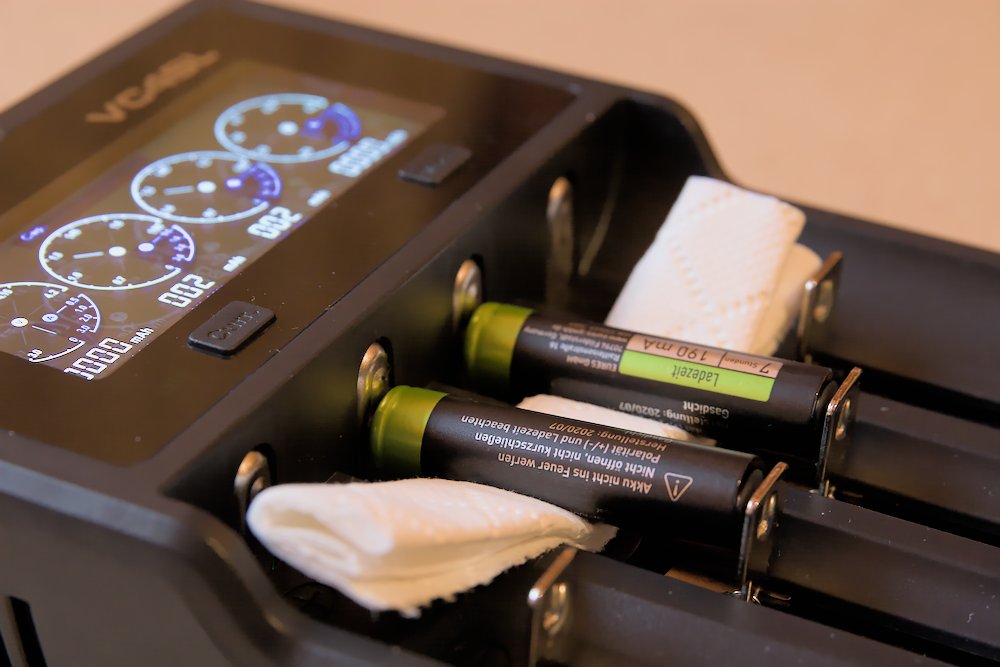Not all flashlights have internal charging, so it’s better to have a proper charger around to charge all your batteries.
XTAR has sent me one of their new chargers for review, the VC4SL. Thank you very much!
Overall it’s similar to the predecessor, the VC4S, but it is longer to support protected 21700 batteries, allows you to set the charging current manually and connects via USB-C.
The charger comes with a protective pouch, a USB A-C cable and a manual in eleven languages. The 18 W QuickCharge USB power supply shown in the picture is available separately and was supplied by XTAR for this review.
With 155 x 115 x 35 mm it is relatively big, but I’m used two dual-slot chargers and this can handle very big batteries as well. So not really a surprise.
Mode, voltage and charging current and other details can be seen on a white/blue/black LCD screen. Right below there are two buttons “Curr” and “Mode” as well as four red/green status LEDs, one for each slot (sadly very dim).
After 60 seconds the screen dims its brightness. By pressing and holding the “Curr” button it can be switched off completely. Good if you don’t want to be disturbed by the charger over night.
It is powered via a USB-C port at the rear side. While a simple 5 V power supply will work (3 A recommended), the full potential is unleashed with a 9 V / 2 A QuickCharge compatible power supply.
The XTAR VC4SL can charge two types of batteries: 3.6/3.7 V li-ion and NiMH. It is compatible with all sizes that physically fit into the device and can be charged with at least 250 mA.
This means: All batteries from 32.5 to 77.5 mm, thus also long protected 21700! Short 18350 fit as well. Cells with a larger diameter (26650 and more) fit into the two outer slots. There’s enough space to charge smaller cells together with 26650.
XTAR mentions following sizes in its manual:
Li-Ion: 10440, 14500, 14650, 16340, 17335, 17500, 17670, 18350, 18490, 18500, 18650, 18700, 20700, 21700, 22650, 25500, 26650, 32650
NiMH: AAAA, AAA, AA, A, SC, C, D
There’s just a small issue with very thin batteries like AAA: They slip under the little nub of the sliding contact and don’t make contact. Raising them a bit with the help of a spacer like shown in the image works, but it doesn’t look nice.
After insertion of the batteries the charger measures their internal resistance to select the appropriate charging current automatically. Afterwards the selected current is shown together with the current voltage in steps on the graphical display.
I’ve noticed that the displayed voltage is higher than in reality: When the display switches to 4.20 V, the real voltage is only 3.9 V (measured in the charger).
Below the graphical display there is a digital display with additional data that can be switched by a short press of the Mode button:
- Capacity (Cap.): Charged capacity since start in mAh. The last digit blinks.
- Current (Cur.): Actual charging current in mA. Not really helpful for NiMH batteries because they are charged in pulses and the displayed current jumps around all the time.
- Internal resistance (IR): Approximated internal resistance in mΩ.
Measurement of the internal resistance is not very accurate. Just move the battery around and it might show a smaller value. But if the contact is good the values are more or less consistent.
By default the charging current is determined automatically from the internal resistance. For my taste the chosen current is too big, e.g. 2 A for an old Sanyo NCR18650GA or also 2 A for an Eneloop AA.
The charging current can be changed manually by pressing the “Curr” button to 3 / 2 / 1 / 0.5 / 0.25 A – but only for all slots together! It is not possible to change it for each slot individually and you can only charge batteries with similar properties together. Not good.
NiMH batteries are charged at 160 mA for the first three and a half minutes (to detect deeply discharged li-ion?). Then the selected current is used.
After the charging has finished the display shows FULL together with the charged capacity and the LED switches to green. Li-ion batteries were charged to about 4.16 V in my tests.
There are additional features in the VC4SL:
- Grading (Grad.): Charge, discharge and charge the battery to measure its capacity.
- Store mode (Store): Charge or discharge to 3.7 V for storage.
The XTAR VC4SL is a simple, easy to use charger for up to four li-ion/NiMH batteries, supporting protected 21700 cells. The store mode comes in handy, the IR measurement is enough to detect very bad batteries. I’d like to see a digital voltage display, because the graphical one is not very accurate.
Manual selection of the charging current is of limited use because it can be set only for all slots together. Also the automatically chosen current is a bit high for my taste.
Overall I think it’s a good charger. You can get it here on AliExpress.






